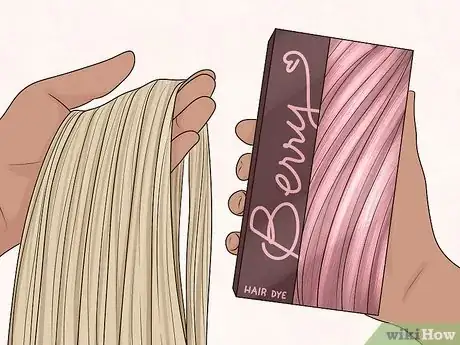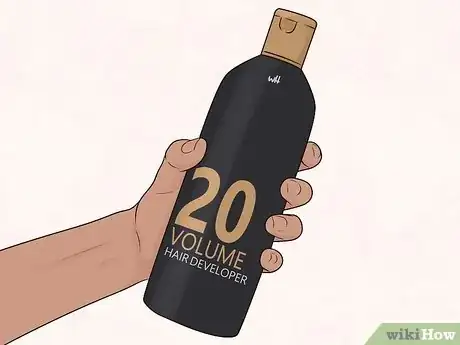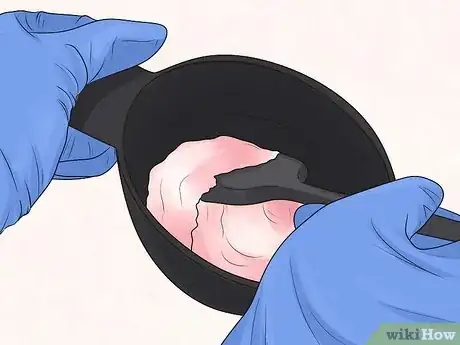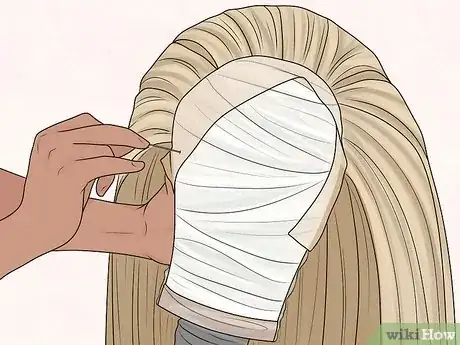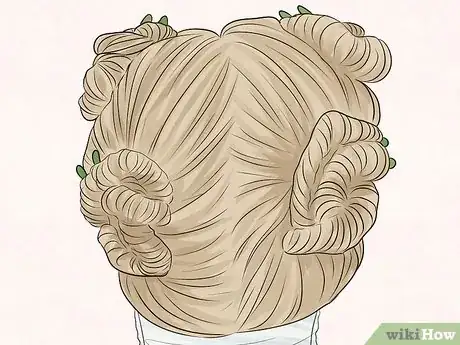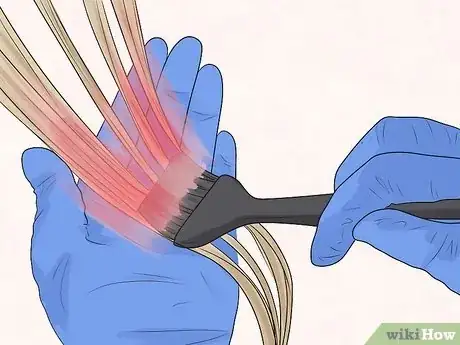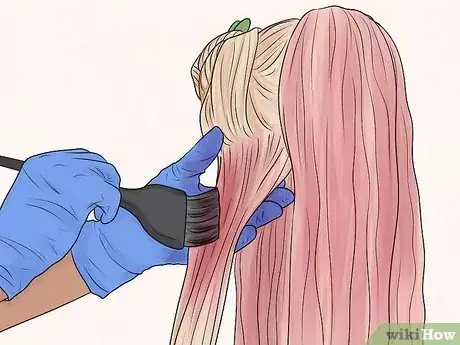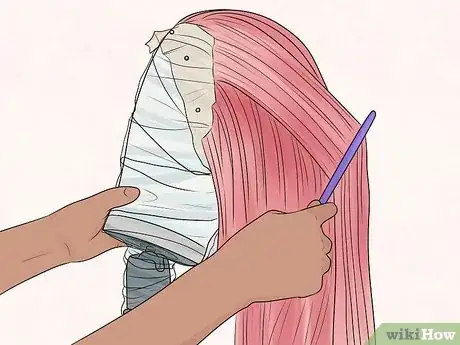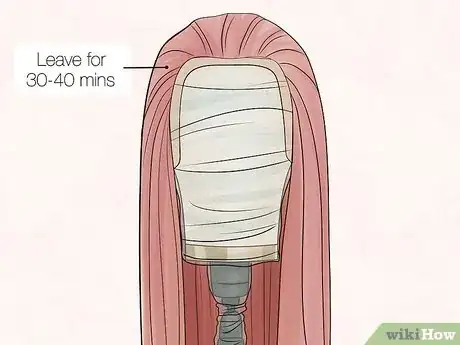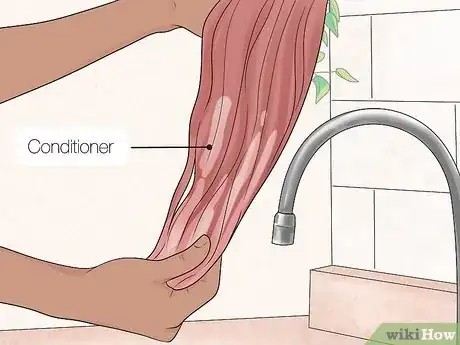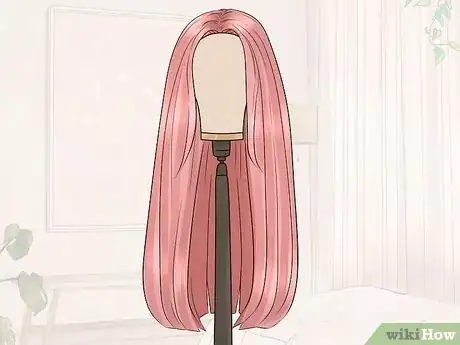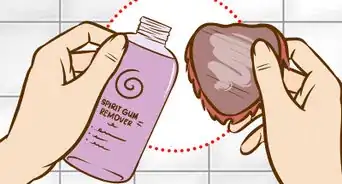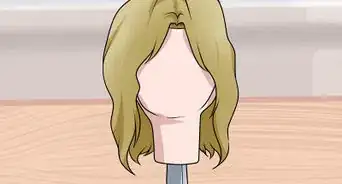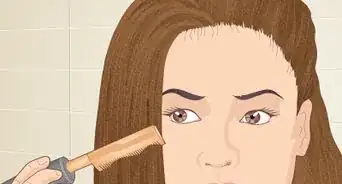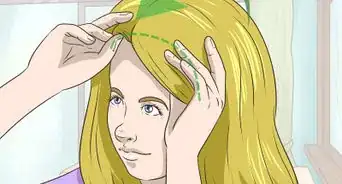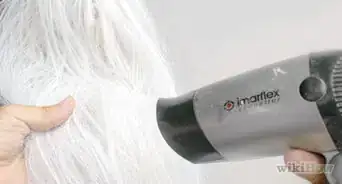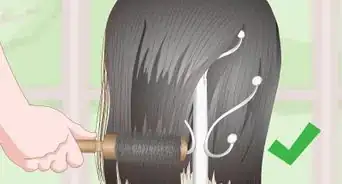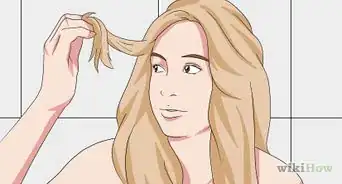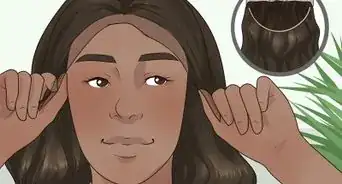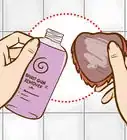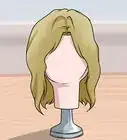This article was co-authored by Nikia Londy and by wikiHow staff writer, Luke Smith, MFA. Nikia Londy is a Hair Augmentation Specialist and the Founder and CEO of Intriguing Hair, a one-stop solution for women from all ethnicities wanting to purchase high-quality human hair extensions, hairpieces, and wigs. With over 16 years of experience, she specializes in artificial hair integrations, hair extensions, hair loss, hairpieces and wigs, and non-surgical hair replacement. Nikia holds a BA in Organizational Leadership from Charter Oak State College and received her Cosmetology Certification from Blaine Beauty School. She is also a member of the American Hair Loss Council.
There are 17 references cited in this article, which can be found at the bottom of the page.
This article has been viewed 188,081 times.
Trying to shake up your look? Or maybe your wig has faded just a bit too much and needs a refresh. Luckily, human hair wigs can be dyed relatively easily (unlike synthetic wigs) —you can use the same hair dye, the same developer, and even the same tools to dye your wig as you would natural hair. We’ve put together a simple, easy guide to choosing a hair color, mixing your dye, and dyeing and drying your wig. Let’s put the luster back in those locks.
Things You Should Know
- Purchase a developer, as well as a natural color hair dye that complements your natural skin tone, or an artificial color that matches your personality.
- Mix the dye and developer together in a plastic bowl before you apply them to the wig.
- Paint the hair dye into the wig in sections, or soak the wig in the hair dye, and let the color set for 30-40 minutes.
- Wash the wig with wig shampoo and conditioner, then pat it dry and finish drying it with a blow dryer.
Steps
Choosing a Color and Mixing Dye
-
1Choose a dye color that’s darker than the wig itself. You can only darken a human hair wig, not lighten it, since the bleach in the dye can damage the hair. To achieve light colors, start with a light-blonde wig or a wig that’s naturally closer to white.[1]
- If you’re going for a natural look, find your skin’s undertones, and use a hair dye color that matches your skin tone: gold and caramel hair tones work well with warm skin tones, blonde and yellow hair tones work with cool skin tones, and neutral skin tones work well with pretty much any hair color (lucky you!).[2]
- For artificial colors: blues are outgoing, oranges are warm and friendly, and purples are imaginative and spiritual.[3] Bright colors like pinks and yellows are fun and bold.
- Don’t dye human hair with fabric dye, which can damage the hair (the last thing we want). Only use hair dye.[4]
-
2Purchase a 20-volume hair developer. Hair developer opens your cuticles to allow hair dye to penetrate your hair, and is sold by “volume,” or penetrating power.[5] A 10-volume may be too weak, a 20-volume developer will let you change the color by one or two shades, while a 30-volume will let you make the hair even darker. In most cases, a 20-volume developer will be just enough to get you that perfect color.[6]Advertisement
-
3Mix the dye and the developer in a plastic bowl. Read the instructions on your dye to see how much dye you should combine with the developer in the plastic bowl. Mix with a plastic spoon. If the dye looks a little light, don’t worry. It will darken over time. Use rubber gloves to protect your hands from irritation or staining.[7]
- If your wig goes down below your shoulders, you may need two boxes of hair dye. It’ll be pricier, but don’t skimp on your hair.
- Do not use a metal bowl or spoon to mix your dye. The metal can oxidize the dye, causing it to change colors.
Applying Dye
-
1Mount the wig on a stand and separate it into 4 sections. A wig stand will keep your wig's shape and style intact while you dye it, and will make it easier to work with the hair. Place the wig on the stand as you would put it on your own head, securing it by pushing T-pins through the wig cap and into the stand.[8]
- If you don’t have a wig stand, you can use a styrofoam mannequin head, or simply use the soaking method below to dye the wig.
- The dye might drip off of the wig. To prevent any stains on your furniture, you can put a towel or plastic tarp around the wig stand.
-
2Gather the hair into 4 separate sections. Use hair ties to make 4 buns on the wig: 2 at the base of the wig, and 2 more toward the front. This will make it easier to manage as you brush-dye the wig, holding strands of hair that you’re not currently dyeing out of the way.[9]
- If your wig is longer or more voluminous, divide it into as many sections as you need to feel comfortable handling the hair.
-
3Test the dye on a few strands of hair. With your fingers or a dye paintbrush, apply the dye to a small section of hair. Test it somewhere that is not easily seen. Wait 30 or 40 minutes. If you like the color, apply it to the rest of the wig. If you don’t totally love it, try a different shade of hair dye.[10]
- Also, do an allergy test prior to applying the dye to the wig if you have particularly sensitive skin. Dab a tiny dot onto the back of your hand and monitor it for 30-40 minutes. If your skin becomes irritated, use a different brand of dye.[11]
-
4Paint the dye into the hair. Starting at the bottom of the wig, take sections of hair and brush the dye into the hair, working from the root to the tip. When you’ve finished applying it to a section, let it hang loose and move on to the next section. Repeat this technique for each of the sections of hair.[12]
- You can also dye by soaking the wig in the bowl with the dye. With your hands, gently scoop the dye over the wig and spread it through the layers of the wig. Be gentle. Try not to roughly rub the dye into the wig.[13]
- You can achieve lowlights by only painting the dye into some strands, or dye either the roots or the ends for a cute dual-tone look.
-
5Brush through the hair. Once you’ve completely coated the hair in dye, use a comb or a wig brush to distribute the dye throughout the wig and ensure that the dye is evenly applied to the entire wig. This will help the dyed hair look more natural, which is key when it comes to human hair wigs.[14]
- Use a clean but old hair brush that you don’t mind staining with hair dye.
-
6Leave the wig for 30-40 minutes to let the color set. Read the package on the dye to see how long you should leave it. In most cases, this will be about half an hour to an hour. If you can’t find this information, check the wig every 10 minutes. When it has reached the right color, you can wash it.[15]
- If you do not have a wig stand, leave the wig in the bowl to set and cover it with plastic wrap.
Washing and Drying Your Wig
-
1Shampoo the wig. Use a color-safe shampoo or a special shampoo manufactured for human hair wigs in particular. Wash the wig by placing it under a tap with warm water to get rid of any excess dye before lathering the wig with shampoo. Rinse out the shampoo when you are done.[16]
- Handle the wig gently, and avoid unneeded tugging or pulling, as this could damage the wig.
-
2Apply conditioner to the tips of the wig. This will give extra shine to your wig. As with the shampoo, only use products approved for or made especially for human hair wigs.[17] Avoid using any conditioner near the roots of a lace-front wig—it could damage the knots that keep the hair in place.[18] Rinse out the conditioner with cool or lukewarm water.
-
3Pat the hair dry with a towel and blow dry it. Gently squeeze the wig with the towel to remove excess water. Hold it with one hand or mount it back on the wig stand, and use a blow dryer on low heat to dry the hair in sections.[19] While you’re drying it, you can style the wig to your liking. Once dry, try it on in the mirror and admire your new ‘do.
- A blow dryer can damage some wigs, or cause some hair dyes to discolor if used immediately after dyeing. Check the dye’s packaging instructions for drying tips, and hang your wig to air dry if you’re unsure.
Expert Q&A
-
QuestionCan you color a human hair wig?
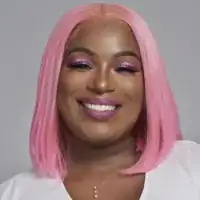 Nikia LondyNikia Londy is a Hair Augmentation Specialist and the Founder and CEO of Intriguing Hair, a one-stop solution for women from all ethnicities wanting to purchase high-quality human hair extensions, hairpieces, and wigs. With over 16 years of experience, she specializes in artificial hair integrations, hair extensions, hair loss, hairpieces and wigs, and non-surgical hair replacement. Nikia holds a BA in Organizational Leadership from Charter Oak State College and received her Cosmetology Certification from Blaine Beauty School. She is also a member of the American Hair Loss Council.
Nikia LondyNikia Londy is a Hair Augmentation Specialist and the Founder and CEO of Intriguing Hair, a one-stop solution for women from all ethnicities wanting to purchase high-quality human hair extensions, hairpieces, and wigs. With over 16 years of experience, she specializes in artificial hair integrations, hair extensions, hair loss, hairpieces and wigs, and non-surgical hair replacement. Nikia holds a BA in Organizational Leadership from Charter Oak State College and received her Cosmetology Certification from Blaine Beauty School. She is also a member of the American Hair Loss Council.
Hair Augmentation Specialist Definitely! Despite popular belief, dyeing your wig does not damage the hair if you do it correctly.
Definitely! Despite popular belief, dyeing your wig does not damage the hair if you do it correctly. -
QuestionWhy doesn't the dye stain the cap/flesh colored part of the wig?
 Community AnswerSince the dye is only meant for real hair, it will likely not dye the cap part of the wig. In most wigs, that part is somewhat resistant to staining. That said, all wigs are different so you should test a very small part to see if yours stains or not.
Community AnswerSince the dye is only meant for real hair, it will likely not dye the cap part of the wig. In most wigs, that part is somewhat resistant to staining. That said, all wigs are different so you should test a very small part to see if yours stains or not. -
QuestionCan I use hairspray on a human hair wig?
 Community AnswerYes, you can. Just realize each bit you add to a wig makes it permanently that way.
Community AnswerYes, you can. Just realize each bit you add to a wig makes it permanently that way.
Warnings
- The more you dye your wig, the more brittle the hair will become. Dying your wig can shorten its lifespan.⧼thumbs_response⧽
- Make sure the temperature of the room is hot, as you won't have the natural heat from your body to help with the dyeing process.[24]⧼thumbs_response⧽
Things You'll Need
- Hair dye
- Dye developer
- Plastic mixing bowl
- Plastic spoon
- Hair dye brush
- Rubber gloves
- Shampoo
- Conditioner
- Wig mount
- Towel
- T-pins
References
- ↑ https://www.hairlossexpert.co.uk/how-dye-your-wig.html
- ↑ https://www.instyle.com/beauty/best-hair-color-for-skin-tone
- ↑ https://littlethings.com/lifestyle/hair-color-ideas-personality-test/604861-5
- ↑ http://www.hairlossexpert.co.uk/how-dye-your-wig.html
- ↑ https://www.curlcentric.com/what-does-hair-developer-do/
- ↑ https://beachwaveperm.com/how-to-dye-a-human-hair-wig-lighter/
- ↑ https://www.youtube.com/watch?v=Pkzwr07wEH0&feature=youtu.be&t=84
- ↑ http://www.hairlossexpert.co.uk/how-dye-your-wig.html
- ↑ https://www.youtube.com/watch?t=41&v=18q0C4o-va4&feature=youtu.be
- ↑ http://blog.baldgirlsdolunch.org/how-human-hair-wigs-are-made-q-a-human-hair-wig-manufacturer
- ↑ Nikia Londy. Hair Augmentation Specialist. Expert Interview. 7 October 2021.
- ↑ https://www.youtube.com/watch?v=18q0C4o-va4&t=50s
- ↑ http://www.hairlossexpert.co.uk/how-dye-your-wig.html
- ↑ http://www.hairlossexpert.co.uk/how-dye-your-wig.html
- ↑ https://www.youtube.com/watch?v=Pkzwr07wEH0&feature=youtu.be&t=264
- ↑ https://www.youtube.com/watch?v=Pkzwr07wEH0&feature=youtu.be&t=289
- ↑ Nikia Londy. Hair Augmentation Specialist. Expert Interview. 7 October 2021.
- ↑ https://www.breastcancer.org/treatment-side-effects/hair-loss/wigs/human-hair
- ↑ https://www.youtube.com/watch?v=WZglu6qGRjk&t=56s
- ↑ Nikia Londy. Hair Augmentation Specialist. Expert Interview. 7 October 2021.
- ↑ https://www.curlcentric.com/how-to-dilute-hair-dye/
- ↑ Nikia Londy. Hair Augmentation Specialist. Expert Interview. 7 October 2021.
- ↑ Nikia Londy. Hair Augmentation Specialist. Expert Interview. 7 October 2021.
- ↑ Nikia Londy. Hair Augmentation Specialist. Expert Interview. 7 October 2021.
About This Article
To dye a human hair wig, you’ll need a hair coloring kit in the color of your choice, a pair of rubber gloves, and a plastic bowl. Put on the rubber gloves and mix the dye and developer together in the bowl. Then, soak the wig in the dye by placing it in the bowl. Use your hands to gently spread the dye through the layers of the wig. Leave the dye to set in the wig for as long as directed on the packaging. When the color is done setting, wash the wig with shampoo and conditioner and allow it to dry. For tips on how to dry your wig after dyeing it, read on!
